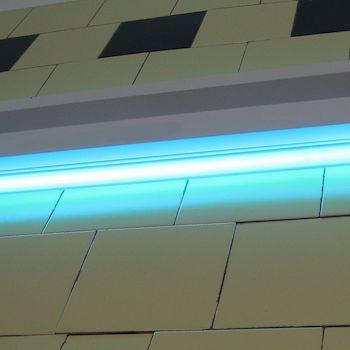UV light is a powerful disinfectant because its high-energy photons are able to damage the genetic material inside of microbes. (The genetic material for most microbes is DNA. However, for some viruses, including coronavirus, the genetic material is RNA1.) DNA damage is also the reason that UV light causes skin cancer.
Since the COVID-19 pandemic began, it's been assumed that UV light can kill SARS-CoV-2. After all, most microbes are susceptible to UV light, and previous research showed that other coronaviruses could be killed by UV. But data was lacking.
Now, a South Korean company called Seoul Semiconductor, which worked in collaboration with Korea University and two American universities, claims to have designed a UV LED (light-emitting diode) that is able to kill 99.9% of SARS-CoV-2 viral particles in 30 seconds. The following graph comes from a press release issued by the company:

Notice that the y-axis is logarithmic. According to their data, after 10 seconds, 1% of viral particles are killed; after another 10 seconds, 10% are killed; and after yet another 10 seconds, nearly 100% are killed.
Unfortunately, there is no published paper, and the press release2 doesn't go into much detail. For instance, it doesn't elaborate on UV light dosage3 (which is measured in µWs/cm2) or at what distance the LEDs operate most effectively4. It does note, as we would expect, that disinfection is more efficient the closer the sample is to the light.
Let There Be (UV) Light!
Earlier, we published an article advocating for the deployment of UV lights in public places, such as airplanes and restaurants, as a way to slow the spread of infectious disease. It's worth trying. At worst, nothing happens; at best, UV light helps prevent epidemics.
Notes
(1) UV-induced RNA damage isn't as well studied as DNA damage, but it does occur.
(2) Amusingly, the press release does say this, emphasis added:
CEO Chung Hoon Lee, who is son of farmer himself, said when Jimmy Carter, the son of a farmer, became the president of the United States, It has become a turning point in life. He express “new history in the light” and “I hope this success story will be a small but heart-breaking story for small and medium-sized manufacturing companies and young start-ups who dreaming of manufacturing”.
(3) See this table for the UV doses necessary to kill a variety of microorganisms. Note that tobacco mosaic virus is very resistant to UV light.
(4) One of the company's product sheets says that the LED has a radiant flux of 3 mW.




